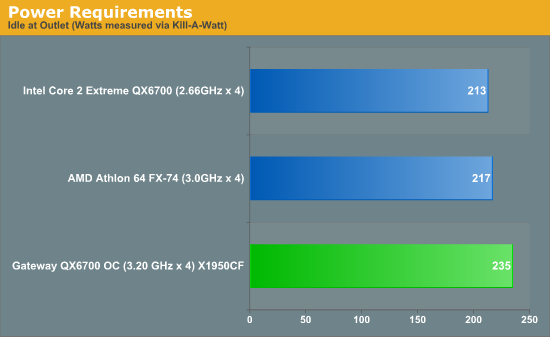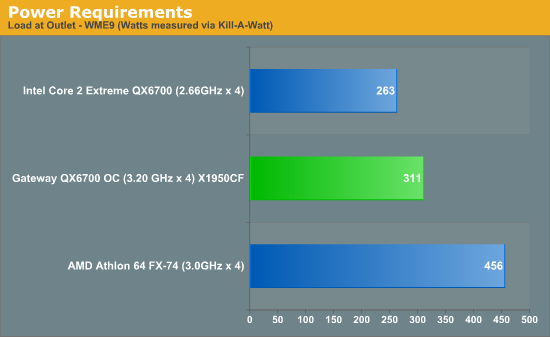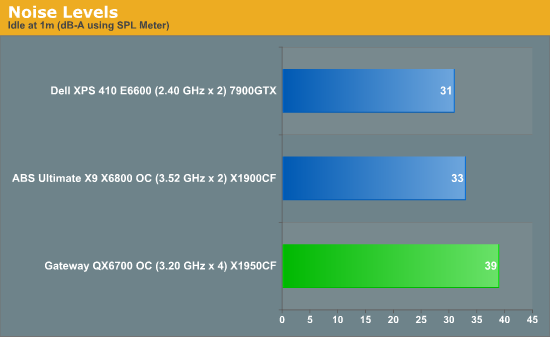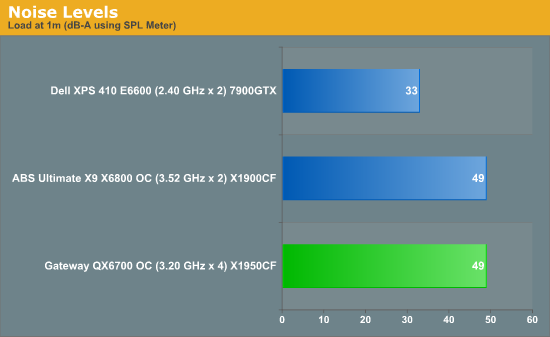Gateway FX530: Mad Cows and Quad Core Overclocking
by Jarred Walton on February 9, 2007 12:01 AM EST- Posted in
- Systems
Power Consumption
Getting this much performance usually comes at a cost, not just in the initial expenditure but also in power bills over time. Intel's Kentsfield processor really isn't all that bad when it comes to power requirements, but Gateway had to jack up the CPU voltage in order to get the overclock to be stable, and combined with the higher clock speed we expect to see higher power draw. We don't have identical configurations, but let's see how the Gateway FX530 stacks up against our own Kentsfield testbed as well as AMD's Quad FX. CPU load was achieved by running the Windows Media Encoder benchmark.


The Gateway FX530 consumes quite a bit more power than our stock Kentsfield configuration, but keep in mind that it has two X1950 XTX graphics cards compared to a single 8800 GTX. Considering the 20% overclock, the power draw a really isn't all that much higher. In comparison to the Quad FX-74 configuration, even an overclocked Kentsfield appears positively thrifty with power use, other than at idle. To make matters worse for Quad FX, the overclocked Gateway system not only uses less power at load, but it also offers significantly better performance. But we already knew that the Quad FX was a difficult platform to justify, so none of this comes as a surprise.
Noise Levels
Given all of the performance being offered, you might expect the Gateway FX530 to be a somewhat noisy computer. While it is by no means silent - particularly when running a CPU intensive task - it's quieter than you might expect. Once again, we tested at idle and load conditions using an SPL meter at a distance of 36".


Compared to several of the other systems that we have reviewed, the Gateway is one of the louder offerings. However, there are some other factors at play. First, even under ideal conditions, the Raptor hard drives kept making periodic clicks that noticeably increased the ambient noise level. As we were testing with the system as configured by Gateway, we expect this sort of behavior to be present for end users. Most likely, one of the various included applications is generating periodic hard drive accesses, and while the Raptor drives are very fast they also tend to be quite a bit more audible than other hard drive solutions. Once we begin to place a load on the CPU, the system fans begin to generate a lot more noise. Even a moderate load on one CPU core immediately increases the fan speeds and noise levels, and as loads are placed on more CPU cores the noise increases until the maximum level of 49 dB is reached.
In general, we would rate the noise levels as being tolerable, and considering the performance offered the noise levels are more than acceptable. This isn't the type of system that would be ideal for use as an HTPC, and we wouldn't recommend having it on in the living room or bedroom if you like to have quiet surroundings in those locales. Depending on how frequently the CPU is fully utilized, the noise levels may be more or less noticeable. More often than not, we would expect a high-end system like this to be stressed by CPU intensive applications, which means the typical noise levels are going to hover at around 44 dB. Trying to keep a system like this quiet is very difficult, however, and we are really quite impressed that Gateway managed to keep noise levels as low as they have.
Getting this much performance usually comes at a cost, not just in the initial expenditure but also in power bills over time. Intel's Kentsfield processor really isn't all that bad when it comes to power requirements, but Gateway had to jack up the CPU voltage in order to get the overclock to be stable, and combined with the higher clock speed we expect to see higher power draw. We don't have identical configurations, but let's see how the Gateway FX530 stacks up against our own Kentsfield testbed as well as AMD's Quad FX. CPU load was achieved by running the Windows Media Encoder benchmark.


The Gateway FX530 consumes quite a bit more power than our stock Kentsfield configuration, but keep in mind that it has two X1950 XTX graphics cards compared to a single 8800 GTX. Considering the 20% overclock, the power draw a really isn't all that much higher. In comparison to the Quad FX-74 configuration, even an overclocked Kentsfield appears positively thrifty with power use, other than at idle. To make matters worse for Quad FX, the overclocked Gateway system not only uses less power at load, but it also offers significantly better performance. But we already knew that the Quad FX was a difficult platform to justify, so none of this comes as a surprise.
Noise Levels
Given all of the performance being offered, you might expect the Gateway FX530 to be a somewhat noisy computer. While it is by no means silent - particularly when running a CPU intensive task - it's quieter than you might expect. Once again, we tested at idle and load conditions using an SPL meter at a distance of 36".


Compared to several of the other systems that we have reviewed, the Gateway is one of the louder offerings. However, there are some other factors at play. First, even under ideal conditions, the Raptor hard drives kept making periodic clicks that noticeably increased the ambient noise level. As we were testing with the system as configured by Gateway, we expect this sort of behavior to be present for end users. Most likely, one of the various included applications is generating periodic hard drive accesses, and while the Raptor drives are very fast they also tend to be quite a bit more audible than other hard drive solutions. Once we begin to place a load on the CPU, the system fans begin to generate a lot more noise. Even a moderate load on one CPU core immediately increases the fan speeds and noise levels, and as loads are placed on more CPU cores the noise increases until the maximum level of 49 dB is reached.
In general, we would rate the noise levels as being tolerable, and considering the performance offered the noise levels are more than acceptable. This isn't the type of system that would be ideal for use as an HTPC, and we wouldn't recommend having it on in the living room or bedroom if you like to have quiet surroundings in those locales. Depending on how frequently the CPU is fully utilized, the noise levels may be more or less noticeable. More often than not, we would expect a high-end system like this to be stressed by CPU intensive applications, which means the typical noise levels are going to hover at around 44 dB. Trying to keep a system like this quiet is very difficult, however, and we are really quite impressed that Gateway managed to keep noise levels as low as they have.










26 Comments
View All Comments
akers - Tuesday, March 20, 2007 - link
Can anyone shead some light on why Gateway is delaying shipment on the FX530? I have had two delays so far and they cannot promise that it will be deliered by the second delay date. I have heard that there were so Vista problems but it was fixed by now.rfaster - Thursday, March 22, 2007 - link
My system arrived last week - I ordered it bare bones with the quad core OC'd to the 3.2.Specs - I put in a 8800GTX (fac OC'd to 600) - 2nd slot so its only running at 4X ( I did not realize this until I read the great article on this site), I'm running 2 150 10K raptor's, 4GB 667 ram. The best I can do is low 9K's on 3DMark 2006 (Running Vista Ultimate 32bit). I'm seeing easy 1,200's from other folks with similar setups.
Question - Is the 4X for Slot 2 causing the SLOWNESS? As you pointed out in your article there is NO way to fit the 8800GTX into slot 1 - so I am trying to decide if I should accept the 4X speed on my $699 8800GTXOC - or ship this pc back. I hate to think that my $699 video card is a WASTE on this system due to the 4X?
rfaster - Thursday, March 22, 2007 - link
Akers - on the delay I was told they are having a difficult time sourcing the parts needed to build this system. I was a bit put off by the delay on getting this box -- reminded me of my experience with Alienware a few years back ----JarredWalton - Monday, March 26, 2007 - link
Right now, Vista plus 8800 GTX is probably going to be a bit slower than normal. Still, I wouldn't worry too much - you can see that your low 9000s score matches what I got in 3DMark06... which is really just a benchmark and not an actual game.Darkskypoet - Thursday, February 15, 2007 - link
Now, correct me if I am wrong... But One of the major hinderances to the Quad FX platform (yes I realize 2 dual core chips is power hungry, and inelegant vs a dual die Quad core) is NUMA, rather the lack of proper NUMA support in XP. Looking at the benchmarks (and in fact all Quad FX bench's) sites continue to use XP variants to benchmark the Quad FX systems vs Conroe. XP does not support NUMA, one article in particular I had read mentioned this fact explicitly, and also mentioned that in many cases accessing data in memory in a NUMA dumb system incresed memory latency SUBSTANTIALLY. Consider that in a NUMA dumb O/S, the data required for a process / thread assigned to one chip, could inadvertantly have it's data stored in memory directly linked to the other CPU. This alone hurts benchmarking scores like crazy. In reality a Quad FX setup, if benched with real SMP/ SMC aware software, should eek out a higher per core performance vs Quad Core Conroe, then an X2 vs Dual Core Conroe.I saw this because the interconnect superiority (When run with NUMA Aware O/S : Vista / Linux / Etc.) will show itself vs the somewhat limited FSB in use in Quad Core C2D implementations; thus increasing performance per core vs Quad Core C2D.
I'm not saying we're gonna see the Quad FX Systems out perform C2D systems here. However, given proper NUMA support, the Benches will be a lot closer. Added to that we can use 2xxx series opterons in QUAD FX, and it starts to become a bit of a nicer picture for AMD. The icing on the cake however, would be that one should expect to be able to drop 2 native Quad Cores on to the QUAD FX boards in the near future.
I believe Nintendo Summed it up for us previously, "Now you're playing with power". If AMD follows this track, then they have a platform out that is fully tested, and stable; running 2 NAtive Quad core chips for the Enthusiast market. As unknown as the Performance of K10 is at this stage, 8 cores with should be mighty interesting. Mighty interesting Indeed.
Anyone know of a Proper NUMA aware OS used in Quadcore C2D vs Quad FX benchmarking?
Tuvoc - Saturday, February 17, 2007 - link
Windows XP x64 edition DOES support NUMA. I have dual Opteron 265s (nicely overclocked from 1.8 to 2.2) and as long as the BIOS is set correctly, then Sandra reports the NUMA statusI also have an Intel Quad core, and it is blindingly fast....
roflsaurus - Tuesday, February 13, 2007 - link
BTX case?JarredWalton - Tuesday, February 13, 2007 - link
BTX is a new form factor that Intel came up with a couple years ago, but the computer parts manufacturers have been relatively slow to adopt it. Basically, it reorganizes the locations of various parts in order to allow for better cooling. Motherboards are also mounted on the offices side of the case, compared to ATX. So where you would open the left side of the case on an ATX system, on the BTX case you would open the right side. If you were to put an ATX motherboard and a BTX motherboard next to each other, on the BTX motherboard everything would appear to be "backwards".Tuvoc - Sunday, February 11, 2007 - link
They say Gateway had to increase the voltage to make the overclock stable - but by how much ? That would have been intresting to know. Also core temps under full load certainly would have been very interestingJarredWalton - Monday, February 12, 2007 - link
The motherboard doesn't appear to work all that well at higher FSB speeds, so Gateway's overclocking is accomplished via changing the multiplier. More on this in a moment.Voltages are also a bit odd. CPU-Z reports 1.238V, but the BIOS is set to 1.450V. Obviously, there's a pretty big difference, and which is more accurate I cannot say. That illustrates the problem with reporting CPU temperatures as well: the BIOS/motherboard implementation will have an impact, as they can read the thermistor differently. Basically, you only end up comparing the Gateway results to itself, and the important thing is that there were no issues with stability when running overclocked.
Back to the FSB stuff. The BIOS has support for adjusting FSB speed and RAM speed, but only in large steps. The FSB can be set to 533, 800, 1067, and 1333 - default being 1067 for Core 2. The RAM can be set to DDR2-400, 533, and 667 (or Automatic). Basically, all of these items select a ratio and bus speed. DDR2-533 represents a 1:1 bus/RAM ratio, while 400 is 3:4 and 667 is 5:4. Using those ratios, you can use the FSB-1333 speed to modify the overclocks a bit. I was able to run the bus at 1333 with DDR2-533 and a 10X multiplier to end up at a 3.33 GHz CPU speed (and a real DDR2 speed of 667).
RAM voltages can be adjusted as well, but only to 1.8, 1.9, 2.1, or 2.2V. I didn't play with these at all. No point in trying to fry Gateway's equipment. I would venture to guess that the CPU could run at 3.3-3.5GHz if you want to push things (3.33 seemed perfectly fine in somewhat limited testing), but again I don't want to push too hard and end up with a dead PC/CPU/RAM/mobo/whatever.
Hope that helps,
Jarred Walton
Editor
AnandTech.com